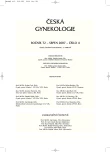Prediction of Intrauterine Growth Retardation Using the Integrated Test Markers
Authors:
P. Urdzík; R. Dankovčík; A. Ostró; I. Lazár
Authors‘ workplace:
II. gynekologicko-pôrodnícka klinika LF UPJŠ a FN L. Pasteura, Košice
prednosta prof. MUDr. A. Ostró, CSc.
Published in:
Ceska Gynekol 2007; 72(4): 268-279
Category:
Original Article
Overview
Objective:
Author’s objective was to ascertain the option for prediction of intrauterine growth retardation using the integrated test markers on the population of pregnant women in Košice city.
Design:
Retrospective, longitudinal, multicenter study.
Setting:
2nd Department of Obstetrics and Gynecology University of P. J. Šafárik, Košice, Slovak Republic.
Methods:
The study group comprised 578 pregnant patients of 2nd Department of Obstetrics and Gynecology, in the period from 01. 11. 2001 until 31. 01. 2005 for integrated test consisting of (examination of the gestation age using CRL, concentration of PAPP-A, NT, AFP, uE3, hCG). Information on birth weight, gender, gestation age at the time of delivery, occurrence of preeclampsia and other pregnancy complications were found in 578 patients retrospectivelly. We have designed two outcome criteria: 1. intrauterine growth retardation <5th fetal weight percentile – IUGR 5 – and intrauterine growth retardation <10th percentile – IUGR 10. In order to make use of the summary information provided by the markers, we have used the method of logistic regression to identify statistically significant predictors of individual binary outcomes (IUGR 5 and IUGR 10). First we developed an equation based on all available predictors. Statistically insignificant predictors were indikátogradually eliminated from the model (Stepwise regression) until the final model remained, for which a ROC curve was developed and values of sensitivity, specificity, positive and negative predictive values at 5% FP (false positivity) were calculated.
Results:
The final model of IUGR 5, containing only statistically significant markers of integrated test achieved – at 5% FP level and 95% specificity level – a 34.8% sensitivity, 24.1% positive and 97.0% negative predictive value - in prediction of birth weight under 5th percentile with respect to gestation age and gender. The final model of IUGR 10, containing only statistically significant markers achieved – at 5% FP level and 95% specificity level – a 36.4% sensitivity, 32.1% positive and 95.8% negative predictive value - in prediction of birth weight under 10th percentile with respect to gestation age and gender.
Conclusion:
Our results, as well as the results of other studies, lead to the conclusion, that in spite of the multitude of biochemical markers and various options for their combination with ultrasound markers, so far it has been impossible to find a combination which would meet the following criteria: 1. high sensitivity and specificity at low false positive values and high positive and negative predictive value, 2. application as a screening method for prediction of intrauterine growth retardation and preeclampsia in unselected population of pregnant women.
Key words:
prediction, IUGR, integrated test, markers
Labels
Paediatric gynaecology Gynaecology and obstetrics Reproduction medicineArticle was published in
Czech Gynaecology

2007 Issue 4
Most read in this issue
- Maternal Position at the Delivery and Perineal Trauma
- Prediction of Intrauterine Growth Retardation Using the Integrated Test Markers
- The Science-Meter Indicators (Citation index, Impact factor, Hirsch-index) and the Evaluation of the Scientific Activity in Medicine
- Occult Anal Sphincter Tear – Up-to-date Knowledge
